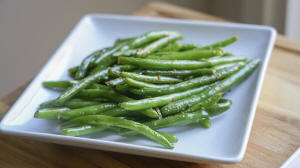What’s the healthiest way to prepare vegetables? The way that makes you
eat them.
 Send a link to a friend
Send a link to a friend
 [January 30, 2025]
By ALBERT STUMM [January 30, 2025]
By ALBERT STUMM
In Carlene Thomas’ experience, two types of people ask her advice as a
dietitian about the healthiest way to prepare vegetables.
Those looking to improve their diet are curious about how different
cooking methods affect nutritional content. Others wonder how best to
work more vegetables into their diet in general.
The simplest version of her answer to both groups is: The best
vegetables are the ones you actually want to eat.
“A lot of people engage in aspirational vegetable shopping” without
actually using them, said Thomas, of Leesburg, Virginia. In that case,
“It doesn’t matter how you cook them, because if they’re going in the
trash, they’re not in your body.”
That said, research shows different cooking methods do affect the
nutritional content of produce, but it’s not as simple as raw vs.
steamed vs. roasted.
Are raw vegetables healthier than cooked?
Not always. Prolonged exposure to high heat degrades many nutrients. But
cooking not only softens the cellular walls in vegetables, making them
easier to digest, it also changes their structure to increase what’s
called bioavailability — the body's ability to absorb the vegetables’
nutrients, Thomas said.

The result is often more nutritious than raw food. Cooked tomatoes, for
instance, release more of the cancer-fighting antioxidant lycopene than
raw, she said, and cooked carrots have more betacarotene that can be
absorbed. Roasting pumpkins, carrots and sweet potatoes boosts
carotenoids, the rich pigments that are antioxidants known to combat
inflammation in the body.
Which cooking methods are the healthiest?
Generally, the shorter the cooking time, the more nutrients are
preserved. Partly because they take relatively little time, steaming and
microwaving are considered the most nutritious methods (also because
they require no fat to cook), said Amber Pankonin, a dietitian in
Lincoln, Nebraska.
A close second is blanching — tossing vegetables into boiling water for
a minute or two — but be careful not to leave them in the water long.
Boiling vegetables, besides easily turning them to mush, runs the risk
of losing water-soluble nutrients including vitamin C, B1 and folate.
“It’s leaching into the water, and you’re tossing out the water,” Thomas
said. “There goes all of the nutrients that you were hoping for.”
Is there no accounting for taste?
Even dietitians say there’s no problem using a small amount of fat.
Besides making vegetables more flavorful, a little cooking oil helps
fat-soluble vitamins absorb in the body, said Pankonin.
That means more vitamin A from squash, carrots and sweet potatoes, more
vitamin D from mushrooms, more vitamin E from bell peppers, leafy greens
and asparagus and more vitamin K from greens, broccoli and onions.
For sauteing, Pankonin recommends starting over medium heat with a
tablespoon of oil, though it depends on the pan. Use enough oil that the
vegetables don’t stick, but not so much that it pools.

[to top of second column]
|

A plate of sauteed green beans is displayed in Lincoln, Neb., on
Oct. 16, 2024. (Amber Pankonin via AP)
 For roasting, you’ll likely need
double the oil per pound of vegetables. Despite the longer cook
time, roasting will still maintain some nutrients and will boost the
flavor with caramelization of natural sugars.
“Flavor is king,” Pankonin said. “I would much rather see people
roasting their vegetables and enjoying them, versus dealing with the
mushy vegetables they’ve boiled and boiled.”
Two recipes below:
___
Amber Pankonin’s Sautéed Green Beans with Lemon, Garlic and Shallots
Serves: 4
Time: 20 minutes
Ingredients
12 oz trimmed fresh green beans
1 Tbsp vegetable oil
1 Tbsp minced shallot
1 tsp minced garlic
1 Tbsp lemon juice
Kosher salt and black pepper
Directions
Blanch green beans by placing in boiling water for 1 minute, drain
and place in an ice water bath. In a sauté pan, add the oil over
medium high and cook the shallots for 30 to 45 seconds. Add the
beans and cook for 2 to 3 minutes. Add the garlic and cook 1 to 2
minutes until the beans are tender. Season to taste with lemon
juice, Kosher salt and black pepper.
___
Carlene Thomas’ Twice-Baked Harissa Sweet Potatoes
Serves: 6
Time: 1 hour, 10 minutes
Ingredients:
3 large sweet potatoes
1 1/2 tsp brown sugar
1 Tbsp butter, melted
2 tsp harissa
Salt and pepper to taste
2 tsp extra-virgin olive oil

Directions:
Wash potatoes and prick with a fork. In the oven preheated to 375 F,
bake for 45 minutes, or until you can pierce with a fork. Remove and
allow to cool slightly before cutting off the top third lengthwise.
Scoop out the flesh using a large spoon (leave enough on the base so
the skin holds its shape) and reserve bases.
In a stand mixer with whisk attachment, add the potato flesh, brown
sugar, harissa, salt and pepper. Whip until fluffy. Scoop into the
reserved potato skins and use a fork to create peaks.
Place potatoes on a baking sheet and brush skins with olive oil.
Bake at 350 F for 25 minutes. Broil on high to brown if desired. Top
with additional salt and harissa.
All contents © copyright 2025 Associated Press. All rights reserved |